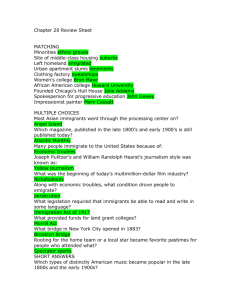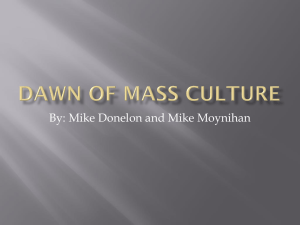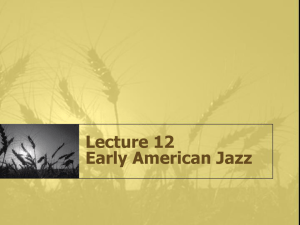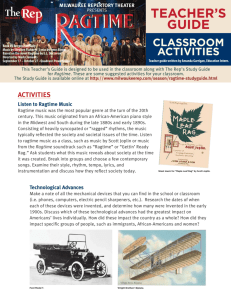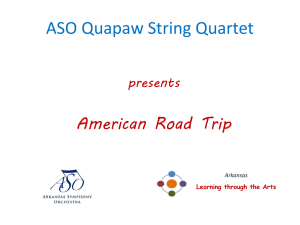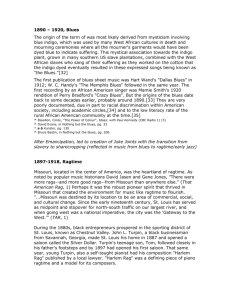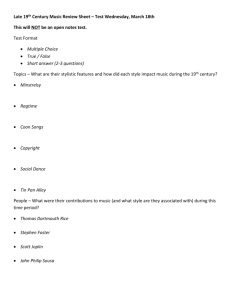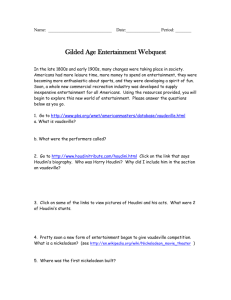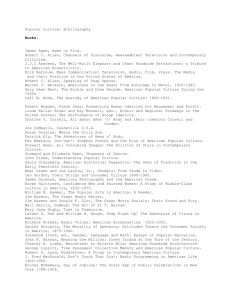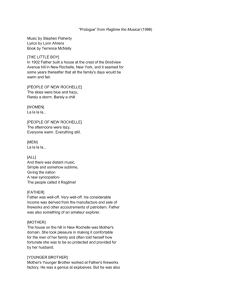PRO Teachers Study Guide - Paragon Ragtime Orchestra
advertisement
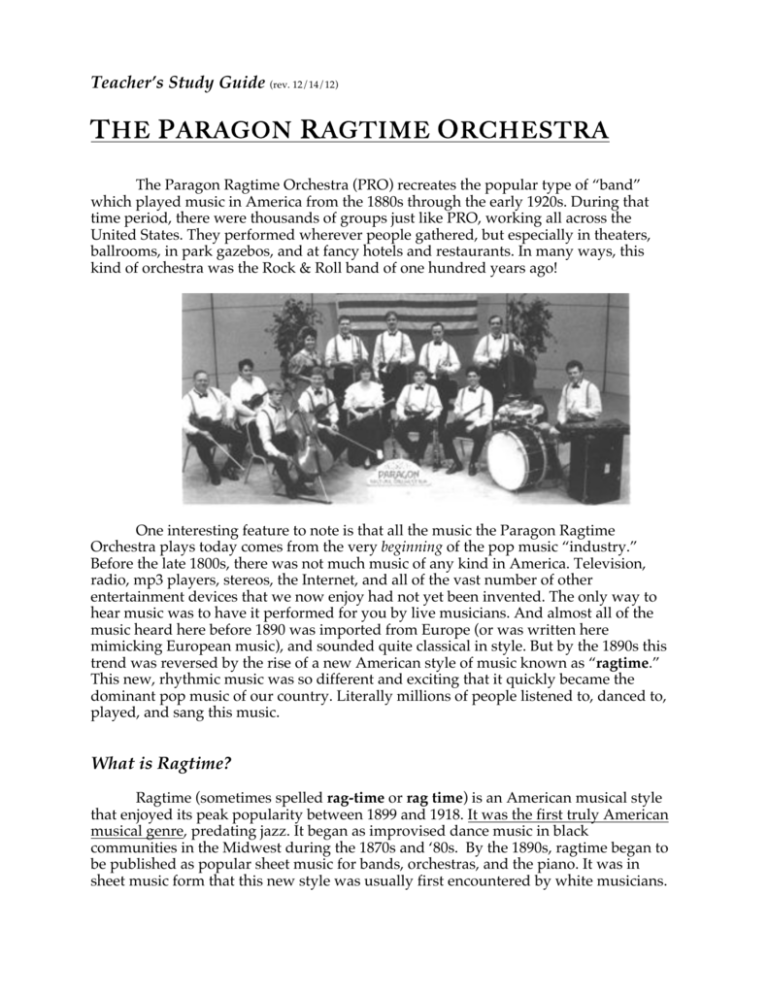
Teacher’s Study Guide (rev. 12/14/12) T HE P ARAGON R AGTIME O RCHESTRA The Paragon Ragtime Orchestra (PRO) recreates the popular type of “band” which played music in America from the 1880s through the early 1920s. During that time period, there were thousands of groups just like PRO, working all across the United States. They performed wherever people gathered, but especially in theaters, ballrooms, in park gazebos, and at fancy hotels and restaurants. In many ways, this kind of orchestra was the Rock & Roll band of one hundred years ago! One interesting feature to note is that all the music the Paragon Ragtime Orchestra plays today comes from the very beginning of the pop music “industry.” Before the late 1800s, there was not much music of any kind in America. Television, radio, mp3 players, stereos, the Internet, and all of the vast number of other entertainment devices that we now enjoy had not yet been invented. The only way to hear music was to have it performed for you by live musicians. And almost all of the music heard here before 1890 was imported from Europe (or was written here mimicking European music), and sounded quite classical in style. But by the 1890s this trend was reversed by the rise of a new American style of music known as “ragtime.” This new, rhythmic music was so different and exciting that it quickly became the dominant pop music of our country. Literally millions of people listened to, danced to, played, and sang this music. What is Ragtime? Ragtime (sometimes spelled rag-time or rag time) is an American musical style that enjoyed its peak popularity between 1899 and 1918. It was the first truly American musical genre, predating jazz. It began as improvised dance music in black communities in the Midwest during the 1870s and ‘80s. By the 1890s, ragtime began to be published as popular sheet music for bands, orchestras, and the piano. It was in sheet music form that this new style was usually first encountered by white musicians. Paragon Study Guide, p.2 A rag is an adaptation of the march (a musical form popularized by bandmasters like John Philip Sousa with pieces like “Stars and Stripes Forever”); ragtime was written in a marching tempo, and also borrowed the compositional structure of march music (three or four separate “themes”). The defining difference though, is ragtime’s constant use of rhythmically “eccentric” melodies, pitted against the steady military march beat (1–2, 1–2, etc). This musical device is called “syncopation.” Syncopation means that a melody is emphasized – accented – in quirky, unexpected places, creating musical tension as it interacts with the evenly spaced bass beats. This creates a delightful, tingly sound, intended to make listeners move their bodies with the beat of the music. Scott Joplin (c.1867-1917), the talented ragtime composer/pianist, called this effect "weird and intoxicating." He also used the term "swing" in describing how to play ragtime music: "Play slowly until you catch the swing..." Interestingly, syncopation has remained at the heart of all of American pop music since the 1890s. Jazz, Country, Rock, and even Rap still use the same syncopations pioneered with Ragtime way back in the 1890s! The cover page of a piece of ragtime sheet music Ragtime Composers Unlike some pop music, ragtime was usually a “composed” style. This means that the notation for the musical sounds were written down in advance, with the idea that performers would read this notation and play the music the same way every time. The most famous ragtime composer to modern audiences is Scott Joplin (c.1867-1917). Joplin was a black musical genius who is now considered to have been greatest Paragon Study Guide, p.3 composer of ragtime music. Amazingly, Joplin was not well known to listeners of his own time. His fame came in the 1970s, when some of his compositions were used for the soundtrack of a hit film called The Sting. Scott Joplin came from humble beginnings: his father had been a slave, and his mother a freeborn domestic servant. Joplin was born near what is now Texarkana, Texas around 1867 (the exact date is not known). He was largely self-educated, played several instruments, (including the violin, guitar, cornet, and the piano), and was a talented singer as well. Joplin was deeply interested in the folk music of his race, as well as the traditions and techniques of European classical music. He wrote many wonderful rags, marches, waltzes, and two steps, in addition to a symphony, a piano concerto, a ballet suite, and two operas. But largely unrecognized and impoverished, Scott Joplin died in a mental hospital on April 1, 1917. He was buried in an unmarked mass grave in Queens, New York. Modern ragtime fans and scholars have also come to recognize Joseph F. Lamb (1887-1960) and James Scott (1886-1938) as two other master ragtime composers. Like Scott Joplin (who was Lamb’s teacher), neither man was truly famous while living. During the Ragtime Era, some nationally known rag composers were George Botsford (1874-1949), Charles L. Johnson (1876-1941), Irving Berlin (1888-1988), Kerry Mills (1869-1948), Joe Jordan (1882-1971), Percy Wenrich (1880-1952), George L. Cobb (18861942), and Arthur Pryor (1872-1942). Perhaps surprisingly, with the exception of Joe Jordan, all of these men were white. And of them, only Irving Berlin is still well known. Paragon Study Guide, p.4 Most people today, if they even think of ragtime music, have the idea that it was only piano music. But this is a modern misconception. During its heyday, rags were written for singers and for instruments such as the banjo, xylophone, and trombone. It was also an exciting ensemble music for bands and orchestras. The Paragon Ragtime Orchestra is an exact copy of the standard type of popular orchestra once found in thousands of American theaters, hotels, restaurants, clubs, and ballrooms. At the height of the Ragtime Era, there were around 30,000 of these orchestras working throughout the country, employing a vast army of professional musicians. These orchestras were extraordinarily important disseminators of ragtime music, and their influence on audiences of the day can hardy be exaggerated. Finney’s Orchestra, Detroit Michigan, c.1898. What Happened to Ragtime? Changes in technology, American society, and musical fashions caused ragtime to disappear as mainstream pop style just after World War I. One reason for its demise was the growing availability of the phonograph, which increased the speed with which musical fads could be spread across the country. With recordings, people were exposed to a larger number of fresh musical choices. And by the early 1920s, radio had also come along and accelerated this effect. Socially, World War I caused such terrible upheaval that afterwards people wanted to sweep away all associations of the happier pre-war days. Many (especially returning soldiers) wanted a fresh new start after the war. Musically, this feeling was represented by jazz, the brash, brassy sound of New Orleans. Thus jazz (also called “Dixieland”) replaced ragtime to become America’s new pop music. While early jazz borrowed much of its rhythms from ragtime, jazz is an improvised music – meaning the performers do not write the music out in advance, but Paragon Study Guide, p.5 make it up as they are performing it. In this way, a jazz tune is different every time it is performed. This is why jazz is fundamentally unlike ragtime, which was a composed music. After its popular decline, ragtime remained in the background until the 1970s, when an array of performers (mainly classical musicians) and scholars issued a number of interesting books about and recordings of the music. By that time, it was realized that ragtime is truly an important and distinctly American art form worthy of serious study and preservation. Ragtime’s “Great Revival” had begun. Today, ragtime is still enjoyed by hundreds of thousands of people around the world, and contemporary composers are even writing brand new rags for modern-day performers and their audiences. Paragon Ragtime Orchestra FAQs: • The PRO is based in Lewisburg, Pennsylvania, and is the world’s only full-time professional ensemble dedicated to preserving and performing music from the Ragtime Era. • Music student Rick Benjamin started PRO in 1985 during lunch in The Juilliard School’s (a classical music conservatory) cafeteria! • In 1987 PRO recorded the outdoor “atmosphere music” still played every day in the Main Street, U.S.A. sections of Disney Land, Disney World, and Disneyland Paris. • The PRO has toured in 48 U.S. states and several foreign countries. It has performed in more than 1,200 North American concert halls and performing arts centers. • PRO has one of largest collections of antique orchestra sheet music (called “orchestrations”) in the world. They have nearly 14,000 different pieces of music! (Over the years they have played 3,000 of these in concert, and recorded about 500 on 14 albums.) At every concert they select “new” scores from their files, so each PRO performance includes tunes that have not been heard for a century or more! • PRO has collaborated with a number of famous artists, including actor Tony Randall, folk singer Tom Chapin, choreographer Paul Taylor, and jazz pianist Butch Thompson. • In 2006 PRO gave the first performance of Scott Joplin’s opera Treemonisha ever presented in the composer’s hometown of Texarkana, Texas. 20 members of the Joplin family attended, and Joplin’s 89 year-old grandniece appeared on stage! Websites: The Paragon Ragtime Orchestra: http://www.paragonragtime.com The Ragtime Ephemeralist: http://home.earthlink.net/~ephemeralist/ Paragon Study Guide, p.6 . Selected References: King of Ragtime by Edward A. Berlin, Oxford University Press, 1994, ISBN 0-19-510108-1. SCOTT JOPLIN Collected Piano Works, Edited by Vera Brodsky Lawrence, The New York Public Library, 1971, ISBN 0-87104-242-8. Ragtime: Its History, Composers, and Music, Edited by John Edward Hasse, Schirmer Books, 1985, ISBN 0-02-872650-2. Further Reading: Berlin, Edward A. (1980). Ragtime: a musical and cultural history. University of California Press. Blesh, Rudi, and Janis, Harriet (1971). They all played ragtime, 4th ed. Oak Publications. Jasen, David A., and Tichenor, Trebor J. (1980). Rags and ragtime. Dover. Schafer, William J., and Riedel, Julius (1973). The art of ragtime: form and meaning of an original black American art. Louisiana State University Press. Paragon Ragtime Orchestra Study Guide – rev. 12/14/12
